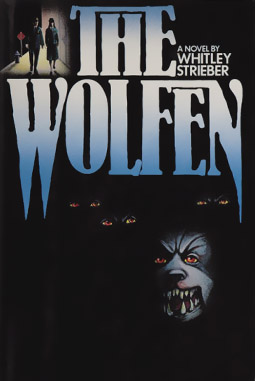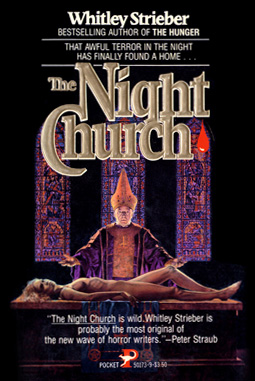


Black Magic

The Wolfen
The Hunger
Night Church

 |
 |

Black Magic |
|

|
|||
The Wolfen |
The Hunger |
The Night Church |
|
![]()
The Wolfen
Published August 1978 (paperback 20 June 1979, feature film 1981)
He would devour the human female. Then the male who loved her. And with them
would die their knowledge of the creatures who had fed on human flesh since
days now remembered only in horror stories.
Detectives Becky Neff and George Wilson knew it
was just a matter of time. If what they had discovered about the Wolfen were
possible, they were being stalked by thinking creatures whose ferocious powers
to kill reduced all of mankind to helpless victims.
And no one believed. They couldn’t. The panic
could destroy every city in the world.
The Wolfen
© 1978 Whitley Strieber
Synopsis courtesy of William Morrow & Company, Inc.
Trivia: To promote the June 1979 paperback release, the opening pages of The
Wolfen (up to the words “Anybody ever hear of a death from wild dogs
in the city? Anybody?”) were presented in the back of some Bantam Books
paperbacks, including Doc Savage #95: The Red Spider.
![]()
The Hunger
Published 3 Feb 1981 (paperback Jan 1982, feature film 1983)
The Hunger is a haunting novel of desire: the desire to banquet on life
with-out satiation; the desire to love without loss; the desire to be young
and remain young and to defeat death through all the ages.
Miriam Blaylock, rich and beautiful, lives life
to the fullest-a house in Manhattan's exclusive Sutton Place, a husband she
adores, priceless antiques, magnificent roses. But then John Blaylock, like
all Miriam's past lovers, suddenly begins to age. Almost overnight, his body
reveals the truth: he is nearly two hundred years old!
Fearing the terrible isolation of eternity, Miriam
stalks a new lover. She is Sarah Roberts, a brilliant young sleep researcher
who has discovered the blood factor that controls aging and thus may possess
the secret of immortality. Miriam desperately wants Sarah, for herself and for
her knowledge. But to win her, Miriam must destroy Sarah's love for Dr. Tom
Haver, who learns that his enemy is like no other woman who has ever lived .
. now or forever.
In The Hunger Whitley Strieber has created
a novel of terrifying reality beyond and within reality itself, and in Miriam
Blaylock he gives us a loving and destructive creature of immortal stature.
Whitley Strieber was born in San Antonio, Texas,
and has lived in New York City for the past ten years. He has traveled through
many parts of the world, working in fields as diverse as intelligence and filmmaking.
His underground films were shown frequently in England in the late sixties.
His other work includes a documentary on the Process Church of Final Judgment,
an unusual religious group that has been connected with satanism. In New York
he has worked as an advertising executive and writer. In recent years, in addition
to writing fiction, he has been developing a new theory about the origin and
true purpose of the Tarot. His first novel was The Wolfen, soon to be
released as a film.
[This bio, from the first edition of The Hunger was not
written by Whitley Strieber, and he regrets that the publisher sensationalized
some parts of his life in this bio, particularly the part about having worked
in fields “as diverse as intelligence...”]
The Hunger
© 1981 Whitley Strieber
Synopsis courtesy of William Morrow & Company, Inc.
Original hardcover jacket design by Paul Bacon
![]()
Black Magic
Published 14 April 1982 (Paperback Feb 1984)
In this maddeningly fast-paced, brilliantly plotted occult thriller, the author
of The Wolfen and The Hunger weaves yet another spell in his quest
to render gratefully sleepless his legion of addicted fans.
His canvas this time has broadened to encompass
the entire world, which is in danger of enslavement or destruction through perhaps
the most insidious weapon ever created: the human mind.
Black Magic begins with a scene of gripping
terror in a Minuteman Missile Control Center deep under the prairies of South
Dakota. When the two highly trained officers on duty encounter a force so hideous
as to make death a refuge, warning is served: a new weapon has rnade American
defenses as vulnerable as an eggshell.
But only one man really understands the nature
of the weapon. He believes in it because he once encountered it, in the wild
Zagros mountains of Iran. There, at the Shah's Institute for Bioenergy Science,
he was shown a boy. And the boy was so strange and so dangerous that the man
almost lost his mind.
PAUL WINTER is the man. He has been retired by
the CIA because he has become obsessed by the boy's potential as a weapon, and
that has made him unreliable.
JAMSHID ROSTRAM is the boy. Androgynous, mysterious,
deeply wounded by a life of injustice and degradation, he claims to his own
people that he is working for the Moslem Brotherhood, when in fact his secret
god is Black Magic and his secret helpers are the Russians.
With Black Magic, Whitley Strieber proves
himself a master of the genre. A tour de force of plotting, character, and solid
research, the book offers extraordinary insights into the hidden workings of
the Soviet military, the technology of spycraft, and some of the terrifying
new weapons that may actually be under development in the Soviet Union today.
As in his previous novels, what Strieber portrays
better than anyone else is the dark side of the heart, the evil impulses that
weed even through altruism, the magic we all perform to blacken our souls and
allow us to create the kind of world we tolerate as our home.
Black Magic
© 1982 Wilson & Neff
Hardcover Jacket design by Paul Bacon
![]()
The Night Church
Published 1983 (Paperback July 1984)
Pray for her.
Pray for her unborn baby.
Pray for all of us.
It is all ugliness and evil. It has no name. She thinks of it
as the snake. It comes in the night, in her dreams. It tells her
in its sneering way something she cannot bear to hear.
You Want to Kiss Me.
It comes closer, ever closer.
It whispers lewdly.
We Can Do It, We Must Do It.
Our Love is the Future,
The Hope of the World...
From the paperback:
In the Night Church, on the alter of the true church, no one will see the rape,
no one will hear the screams of ecstasy – no one except the devil’s
disciples...
She is young, infinitely desirable, the virgin
bride. He is young, incredibly brilliant, the devil’s groom. They are genetically
perfect, programmed to plant a seed of flesh, destined to breed a mutant life
– of overwhelming beauty and overwhelming evil. Evil which will emerge
as the anti-human, evil which will use cold, sinister technology to wipe out
the world – our world. Now it is a matter of life and death. For them.
For us. For humankind.
From the hardcover:
By day Holy Spirit is parish center to the folk of Richmond Hill and Kew Gardens
in New York's very mundane borough of Queens. By day Father Harry Goodwin serves
his dwindling flock of Irish and Italian widows and struggles vainly to meet
his bills. By night the Spirit is host to quite another constituency: a huge,
rich and gaudy congregation that meets for rituals of a very different kind.
In the small hours Holy Spirit offers no sanctuary
to the innocent. For Jonathan Titus Banion and Patricia Murray, solving the
riddle of the Night Church and their role in its ancient hierarchy is a matter
of life and death-for themselves and for civilization as we know it.
Whitley Strieber, author of The Wolfen
and The Hunger, has been praised by Peter Straub for his “pure and
original invention.” Nowhere are these powers more dramatically in evidence
than in this eerie novel of an alternate church – a church with its roots
in the plague-ridden darkness of the Middle Ages and its sinister tentacles
in the technological future, a church eternally at war with the militant priests
of the Holy Inquisition. The Night Church may possess you.
The Night Church
© 1983 Wilson & Neff, Inc.
Synopsis courtesy of Simon & Schuster, Inc.
Paperback Cover artwork by Bill and Maurine Klimy